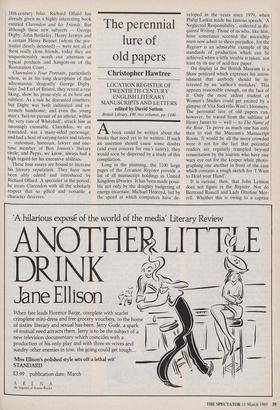Hangers-on at the court of Charles II
Peter Quennell
CLARENDON'S FOUR PORTRAITS edited by Richard ()Hard
Hamish Hamilton, £15.95, pp.144
Accomplished literary stylists, in days gone by, have often also been expert portraitists, whose love of language had developed into a keen concern with the mysteries of human nature. Certainly this was true of many English prose-writers during the second half of the 17th century, From Clarendon to Halifax, besides chronicling the events of their own age, they drew a series of brilliant verbal portraits in which the men they had known best are described and analysed at length. Their sympathies were widely, extended. Thus, in his History of the Rebellion, his account of the Civil Wars, written abroad in exile but published between 1702 and 1704, Clarendon paid Oliver Cromwell an extraordinary tribute:
Without doubt, no man without more wick- edness ever attempted anything, or brought to pass what he desired more wickedly... Yet wickedness as great as his could never have accomplished those trophies without the assistance of a great spirit, an admirable circumspection, and sagacity, and a most magnanimous resolution.
Towards the end of the same century, Halifax produced a minor masterpiece, his Character of King Charles II, a vivid portrait of Clarendon's unworthy master, whom he explains but cannot wholly con- demn, since the sovereign's idleness and self-destructive egotism amounted almost to an inherited neurosis:
When once the Aversion to bear Uneasiness taketh place in a Man's mind, it doth so check all the Passions that they are damped into a kind of Indifference.., This made that he had as little Eagerness to oblige as he had to hurt Men; the Motive of his giving was rather to make Men less uneasy to him than more easy to themselves; and yet no i11 nature all this while. He would slide from an asking face ...
Clarendon's analyses of character were just as acute; and his main portraits have long been well-known. But here are four rewarding additions that have recently come to light after 200 years' obscurity as a supplement printed in a small edition of an 18th-century folio. Richard 01lard has already given us a highly interesting book entitled Clarendon and his Friends. But although these new subjects — George Digby, John Berkeley, Henry Jermyn and a certain Henry Bennet (whom the por- traitist clearly detested) — were not all of them really close friends, today they are unquestionably worth our attention as typical products and hangers-on of the Restoration Court.
Clarendon's Four Portraits, particularly when, as in his long description of that adventurous 'dragonfly' George Digby, later 2nd Earl of Bristol, they reveal a real liking, show his prose-style at its best and subtlest. As a rule he distrusted courtiers; but Digby was both cultivated and ex- tremely handsome; and even the young man's 'furious pursuit of an amour, within the very ears of Whitehall', struck him as amusingly excusable. Clarendon, we are reminded, was a many-sided personage, and had a host of varying tastes and talents — statesman, historian, lawyer and one- time member of Ben Jonson's literary circle; and Pepys, we know, always had a high regard for his executive abilities.
These four essays are bound to increase his literary reputation. They have now been ably edited and introduced by Richard 01lard. A specialist in the period, he treats Clarendon with all the scholarly respect that so gifted and versatile a character deserves.



























































 Previous page
Previous page